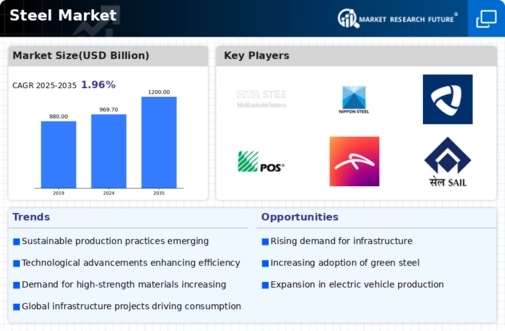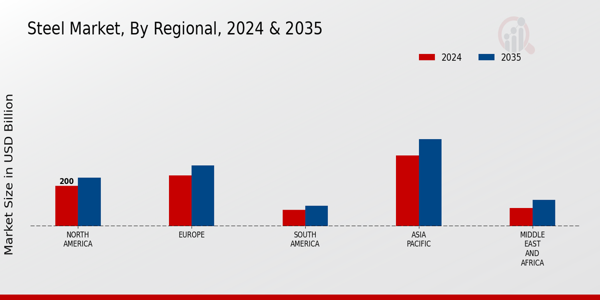Market Trends and Projections
The Global Steel Market Industry is characterized by various trends and projections that reflect its dynamic nature. Current estimates suggest that the market will reach 969.7 USD Billion in 2024, with a potential growth trajectory leading to 1200 USD Billion by 2035. The anticipated CAGR of 1.96% from 2025 to 2035 indicates a steady growth pattern, influenced by factors such as infrastructure development, automotive demand, and technological advancements. These trends underscore the evolving landscape of the Global Steel Market Industry, highlighting the interplay between demand drivers and market dynamics.
Growing Demand for Green Steel
The Global Steel Market Industry is witnessing a paradigm shift towards green steel production, driven by increasing environmental regulations and consumer preferences for sustainable products. Green steel, produced with lower carbon emissions, is becoming a focal point for manufacturers aiming to reduce their carbon footprint. This trend is particularly relevant as countries commit to achieving net-zero emissions by mid-century. The rising demand for green steel is likely to influence production methods and supply chains, potentially reshaping the market landscape. As sustainability becomes a priority, the Global Steel Market Industry may experience significant transformations in the coming years.
Rising Demand from Automotive Sector
The automotive sector is a significant driver of the Global Steel Market Industry, as manufacturers increasingly rely on steel for vehicle production. With the push towards electric vehicles, the demand for lightweight yet strong materials is intensifying. Steel's versatility allows for innovative designs that enhance fuel efficiency and safety. As the automotive industry evolves, the Global Steel Market Industry is expected to benefit from this shift. By 2035, the market could reach 1200 USD Billion, largely fueled by the automotive sector's transition to more sustainable practices. This trend indicates a robust future for steel as a primary material in vehicle manufacturing.
Increasing Infrastructure Development
The Global Steel Market Industry is experiencing a surge in demand driven by increasing infrastructure development across various regions. Governments are investing heavily in infrastructure projects, including roads, bridges, and railways, to stimulate economic growth. For instance, in 2024, the market is projected to reach 969.7 USD Billion, reflecting the critical role of steel in construction. This trend is expected to continue as urbanization accelerates, particularly in developing nations, where the need for robust infrastructure is paramount. The ongoing investments in infrastructure are likely to bolster the demand for steel, thereby enhancing the overall growth of the Global Steel Market Industry.
Expansion of Renewable Energy Projects
The expansion of renewable energy projects is significantly impacting the Global Steel Market Industry. Steel is a crucial material in the construction of wind turbines, solar panels, and other renewable energy infrastructures. As countries invest in clean energy solutions, the demand for steel is expected to rise correspondingly. This trend aligns with global efforts to transition towards sustainable energy sources. The increasing focus on renewable energy could contribute to the overall growth of the Global Steel Market Industry, as investments in these projects are likely to drive steel consumption in the coming years.
Technological Advancements in Steel Production
Technological advancements are reshaping the Global Steel Market Industry by improving production efficiency and reducing environmental impact. Innovations such as electric arc furnaces and advanced metallurgy are enabling steel producers to optimize their operations. These technologies not only enhance productivity but also align with global sustainability goals. As a result, the industry is likely to witness a compound annual growth rate (CAGR) of 1.96% from 2025 to 2035. The integration of new technologies is expected to attract investments, further driving the growth of the Global Steel Market Industry as companies seek to remain competitive in a rapidly evolving landscape.



















Leave a Comment